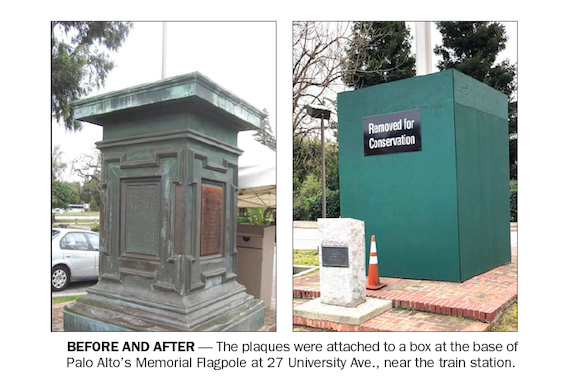
BY BRADEN CARTWRIGHT
Daily Post Staff Writer
Stanford has removed large bronze plaques that honored Civil War veterans and California pioneers at the base of a flagpole in downtown Palo Alto for over 100 years, and a group of veterans says the university has desecrated “a civic shrine and landmark.”
University representatives told the veterans group that copper thieves are to blame, and the plaques were removed from the base of the Memorial Flagpole for their own protection after a piece of copper was stolen.
A green plywood box was put up around the base of the flagpole some time in fall 2020 with a sign that says, “Removed for conservation.”
That caught the attention of American Legion Palo Alto Post 375, a veterans group that maintains the flag and holds meetings and events in the historic building at 27 University Ave.
Air Force veteran Raymond Powell contacted Stanford’s real estate division, the property owner since 1999, to find out where the plaques went.
University archaeologist Laura Jones told him that the flagpole had been “repeatedly damaged by copper thieves,” and the plaques were in danger, according to emails published by Post 375.
She sent pictures showing a strip of copper had been apparently pried off of the bronze base.
Stanford had the plaques “carefully dismounted” and “secured at her archaeology lab on campus,” Jones said.
One of the plaques is dedicated to a group of Civil War veterans who organized in Palo Alto on Jan. 21, 1905. The plaque was dedicated and placed in 1918, when there were 14 living members remaining in the group, according to the inscription.
Two plaques honor Native Sons and Native Daughters of the Golden West, nonprofits focused on California history that formed in 1886.
Another plaque lists 12 members of the California Pioneers of Santa Clara County, a group that lasted from 1875 to 1909, according to the inscription.
Will Von Kaenel, commander of Post 375 and Stanford alumnus, said Stanford’s explanation doesn’t make sense, and officials should’ve reported the alleged vandalism to police when it happened.
“Stanford officials have never provided evidence, forensics, rationale or expert opinion to attribute the flagpole’s damage to ‘copper thieves,’” he said. “These officials’ professional expertise is in anthropology and property management, not forensics or law enforcement.”
Copper prices were at a four-year low when the piece went missing, and the scrap metal would’ve been worth less than $30, Von Kaenel said.
The flagpole had been there for 117 years without copper theft, and plaques in other parts of the city are doing fine, he said.
“We have a veterans memorial desecrated, and it wasn’t reported,” Von Kaenel said in an interview yesterday.
He pointed out that Stanford presented plans to the city last year for developing the area around the train station.
The Memorial Flagpole was placed on the National Register of Historic Places in 1975 along with the building known as the Veteran’s Memorial Building or the Hostess House.
The building was designed by architect Julia Morgan and built in 1918, and it was the first city-owned community center in the United States, according to the Palo Alto Historical Association. Stanford took ownership of the building in 1999.
Stanford currently rents the building to the MacArthur Park restaurant.
The city’s Historic Resources Board scheduled a study session to discuss the Memorial Flagpole on April 13, and Jones will give a presentation at the meeting, Chief Planning Official Amy French told Von Kaenel.
Jones declined a request for an interview yesterday, and a Stanford spokesman is looking into questions about the alleged copper theft.
Von Kaenel sent the city a 38-page report that details the Memorial Flagpole’s history, with an 1898 picture showing it where the University Avenue circle was later built.
Residents gathered for a dedication of the flagpole in 1908, and it was moved to its current location in 1941, photos from the Palo Alto Historical Association show.
The pole has been shortened several times, and Boy Scouts have used it for flag-raisings, photos show.
